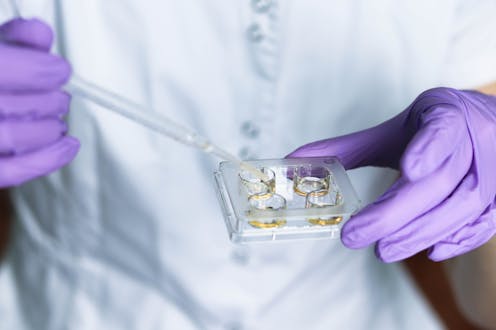What's the right way for scientists to edit human genes? 5 essential reads
- Written by Maggie Villiger, Senior Science + Technology Editor

Since scientists first figured out how to edit genes with precision using a technology called CRISPR, they’ve been grappling with when and how to do it ethically. Is it reasonable to edit human genes with CRISPR? What about human genes in reproductive cells that pass the edits on to future generations?
The International Commission on the Clinical Use of Human Germline Genome Editing[1] convened on Aug. 13 to hash out guidelines about editing human embryos. The goal is to provide a framework that researchers around the globe can consult to ensure their work is in line with scientific consensus.
An earlier U.S. National Academies committee had already released recommendations in 2017. They called for caution – but were ambiguous enough for Chinese scientist He Jiankui to suggest he’d followed them even as he produced twin girls with CRISPR-edited genomes[2] late last year.
Here are five stories from our archive that explore how to ethically develop and regulate a potentially risky new technology.
1. A voluntary pause
No one denies the power of the CRISPR editing tool. It could allow doctors to one day cure genetic diseases, whether in adults who are living with medical conditions or in embryos that have not yet even been born. But there’s a lot of lab work yet to be done, as well as many conversations to be had, about the right way to proceed.
In 2015, a group of prominent scientists called for a voluntary freeze on germline editing – that is, changing sperm, eggs or embryos – until ethical issues could be resolved.
Chemical biologist Jeff Bessen[3] wrote that this approach has precedents in the scientific community, where many think it makes sense to take things slow and place “the right emphasis on safety and ethics without hampering research progress[4].”
2. Stringent hurdles before proceeding
The National Academies’ 2017 report was meant to provide the scientific community with definitive guidance on the issue.
Rosa Castro[5], a scholar of science and society, explained that the report gave the green light to modifying body cells and a yellow light to modifying reproductive cells that would allow the changes to be inherited by future progeny. The report’s goal was to ensure that “germline genome editing will be used only[6] to prevent a serious disease, where no reasonable alternatives exist, and under strong supervision.”
3. Science marches on
By later that year, a research group announced they’d successfully used CRISPR to modify human embryos, though the edited embryos weren’t implanted in women and were never born. Bioethics and public health professor Jessica Berg[7] wrote about the importance of working out the ethical issues[8] of gene editing before researchers take the critical step of allowing modified embryos to develop and be born as babies.
“Should there be limits on the types of things you can edit in an embryo? If so, what should they entail? These questions also involve deciding who gets to set the limits and control access to the technology.
"We may also be concerned about who gets to control the subsequent research using this technology. Should there be state or federal oversight? Keep in mind that we cannot control what happens in other countries.
"Moreover, there are important questions about cost and access.”
4. Babies born with edited genomes
Most of the world reacted with shock in 2018 when a Chinese researcher announced he’d edited the germline cells of embryos[9] that went on to become twin baby girls. His stated goal was to protect them from HIV infection.
This development seemed to many researchers to be in violation of at least the spirit of the 2017 guidelines around human gene editing. Biomedical ethicist G. Owen Schaefer[10] described the central objection: that the procedure was simply too risky, with the potential for unexpected and harmful health effects later in the girls’ lives outweighing any benefit.
He wrote that the “CRISPR babies” are “part of a disturbing pattern in reproduction: rogue scientists bucking international norms[11] to engage in ethically and scientifically dubious reproductive research.”
5. Rules and regs don’t guarantee ethical work
Whatever the outcome of the current meeting, there may be a distinction between sticking to the rules and doing what’s right. Arizona State professor of life sciences J. Benjamin Hurlbut[12] and applied ethicist Jason Scott Robert[13] underscored this point after Chinese scientist He Jiankui claimed he checked off the boxes laid out by the 2017 guidelines.
“Public debate about the experiment should not make the mistake of equating ethical oversight with ethical acceptability[14]. Research that follows the rules is not necessarily good by definition.”
Guidelines and expectations can help define what the scientific community finds acceptable. But complying with the routines of oversight doesn’t guarantee a project is ethical. That’s a much more complicated question.
Editor’s note: This story is a roundup of articles from The Conversation’s archives.
References
- ^ International Commission on the Clinical Use of Human Germline Genome Editing (nationalacademies.org)
- ^ twin girls with CRISPR-edited genomes (theconversation.com)
- ^ Jeff Bessen (theconversation.com)
- ^ safety and ethics without hampering research progress (theconversation.com)
- ^ Rosa Castro (theconversation.com)
- ^ will be used only (theconversation.com)
- ^ Jessica Berg (scholar.google.com)
- ^ working out the ethical issues (theconversation.com)
- ^ edited the germline cells of embryos (theconversation.com)
- ^ G. Owen Schaefer (scholar.google.com)
- ^ rogue scientists bucking international norms (theconversation.com)
- ^ J. Benjamin Hurlbut (theconversation.com)
- ^ Jason Scott Robert (scholar.google.com)
- ^ equating ethical oversight with ethical acceptability (theconversation.com)
Authors: Maggie Villiger, Senior Science + Technology Editor

